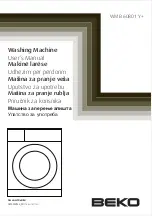
BNP DOUBLE 65 and DOUBLE 220 - DUAL STATION SUCTION CABINET Page 12
© 2016 CLEMCO INDUSTRIES CORP.
www.clemcoindustries.com
Manual No. 22963 Rev. D, 07/16
5.5.2
To Remove More Fines:
(Too much dust in
media) Raise the cylinder by moving the lever left toward
"COARSE", in 1/4" increments at the indicator plate.
Allow the media to go through several blast cycles
before determining is further adjustment is required.
5.5.3 To Remove Less Fines:
(Excessive usable
media is carried to the dust collector) Lower the vortex
cylinder by moving the lever right toward "FINE", in 1/4"
increments at the indicator plate. NOTE: If the cylinder is
lowered too far, the reclaimer will again begin to allow
usable media to be carried over, and cause abnormally
high static pressure.
5.5.4
When using media finer than 180-mesh, the inlet
baffle of the reclaimer may need to be removed. Refer to
Section1.8.6.
Figure
16
5.6
Cabinet Air-Inlet Dampers
5.6.1
Once the inlets are initially set per Section 2.6, it
seldom requires readjustment. The initial setting
produces approximately .5
to .75
of static pressure in
the cabinet enclosure.
Do not confuse cabinet static
pressure with reclaimer static pressure, which is
controlled by the dust collector ventilation-damper
as noted in Section 5.4. Reclaimer pressure must be
set before cabinet pressure.
5.6.2
Using a manometer (as noted in Section 5.8 and
listed in Section 9.1) is the most accurate method of
monitoring and adjusting cabinet pressure. Following the
instructions packed with the manometer, start the
exhauster and insert the needle into a glove, and adjust
pressure using the cabinet’s air-inlet damper. Open the
damper farther to decrease static pressure or close it
farther to increase pressure.
5.6.3
If a manometer is not available, use the gloves
as an indicator. With the exhauster ON, the gloves
should be inflated, but not elevated off the grate.
5.7
Door Interlocks, Figure 17
WARNING
Never bypass the door interlock system. Doing
so could result in injury from unexpected
blasting.
5.7.1
The door interlocks disable the blasting control
circuit when doors are open. To enable blasting, the
door interlock switches must be engaged when doors
are closed. The interlocks are set at the factory and do
not normally require field adjustment unless parts are
replaced. When adjustment is required, proceed as
follows.
5.7.2
Close cabinet doors.
5.7.3
Loosen the actuator bracket screws and
adjusting screw nut. Move the actuator adjusting bracket
up or down, and the adjusting screw sideways, to center
the adjusting screw on the over-travel stop. Tighten the
bracket screws.
Figure 17
5.7.4
Turn the adjusting screw in or out as required to
engage the switch without applying excessive pressure
on it. Tighten the adjusting screw nuts.
5.7.5
Test the operation with the doors open and then
again closed. Point the nozzle away from the door during
the tests, and open the door only enough to disengage
Remove more fines
from media by
moving the handle
farther to the left
Remove less
fines by moving
the handle farther
to the right
Tensioning Knob
Adjust the screw to depress
the over-travel stop when
door is closed.
Actuator Bracket
Over-travel Stop
Detent Sleeve
Adjusting Screw Nut
Loosen both nuts and move
screw sideways as needed to
center adjusting screw-head
on the over-travel stop.
Cabinet Door
Loosen bracket screws and
move bracket up or down as
needed to center adjusting
screw-head on the over-
travel stop.
Bracket Screws














































